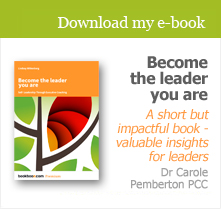Self-leadership

Leading others demands the capacity to lead ourselves
In all the talk, all the programmes, all the tools and techniques about leadership, we hear a lot about how to lead others, but how often do we hear about self-leadership? And yet unless we know how to lead ourselves, we can’t expect to be effective leaders of others.
Executive coaching equips leaders to self-lead
Executive coaching plays a key role in facilitating self-leadership. The executive coach is responsible for creating conditions in which the leader can become equipped to clarify and assess their situation, draw lessons from it, work out their options, create opportunities, make positive and sustainable changes, and make decisions that are congruent with the person they are, and what they want to achieve. The coaching journey enables the leader to create and discover insights which they can experiment with in the conduct of their own working lives (‘self-leading’), and then apply to leading others.
Development and transformation through executive coaching
Leaders I coach achieve development and transformation: they make profound and sustained changes in themselves, in their teams, in the philosophy and practices of their organisations, in their effectiveness, and in the quality of outcomes they create. They learn to self-coach, becoming better able to question assumptions, old beliefs, and behaviours that limit their effectiveness. They might subconsciously have been carrying all these around with them for years – and through coaching they understand how to integrate new knowledge into their practices, and they get to know at a profound level who they really are.
Outcomes from self-coaching
Their self-coaching engenders a capacity for self-leadership as a pre-condition for leading others. The leader learns to tap in more fully to their capabilities – so they become more effective at achieving the outcomes they want. They think freshly, from new perspectives, and they feel safe enough to think creatively – so they create new solutions. They discover what helps them and what hinders them in achieving the right outcomes – so they’re better able to make decisions and judgments which are well-grounded, and which make their results sustainable. They create and sustain productive working relationships and get the best out of their people. They propel their careers and their organisations forward, they learn what might be in their way – and they learn how to address those barriers.
Self-awareness and self-understanding
High-quality leadership isn’t a check-list: it’s a question of how the leader brings the essence of themselves to their role, and for this, leaders need to courageously examine their own practices and thinking, to be ready for – and embrace – some uncomfortable learning and, most importantly, to build their self-awareness. They need to develop self-understanding, awareness of how others tick, and a capacity to put themselves in those others’ shoes. This quality of leadership requires an awareness of how the systems of relationships and influences around them work and how they impact on each other, a curiosity to keep learning (especially when things go wrong) and a discipline to keep applying the learning.
The opportunity of choice
Awareness and understanding create the opportunity for choice – choice about behaviour and thinking, so as to avoid falling into the rut of habit, to ensure response rather than reaction, to apply curiosity and to take a strategic perspective on judgments and decisions.
Benefits of self-leadership
The self-leader is a leader who is likely to be inspiring, to engender high levels of engagement and retention in their teams and organisations, to foster learning and innovation, and to nurture excellence.
The journey to self-leadership isn’t always an easy one, but – if my clients re anything to go by – it’s a journey that can bring more rewards than were ever anticipated.
e-book: ‘Become the Leader You Are’
If you’re interested to learn more about self-leadership, see my e-book ‘Become the Leader You Are: Self-Leadership Through Executive Coaching’ and click ‘Buy this book’
Photo by Scott Norris via Compfight


